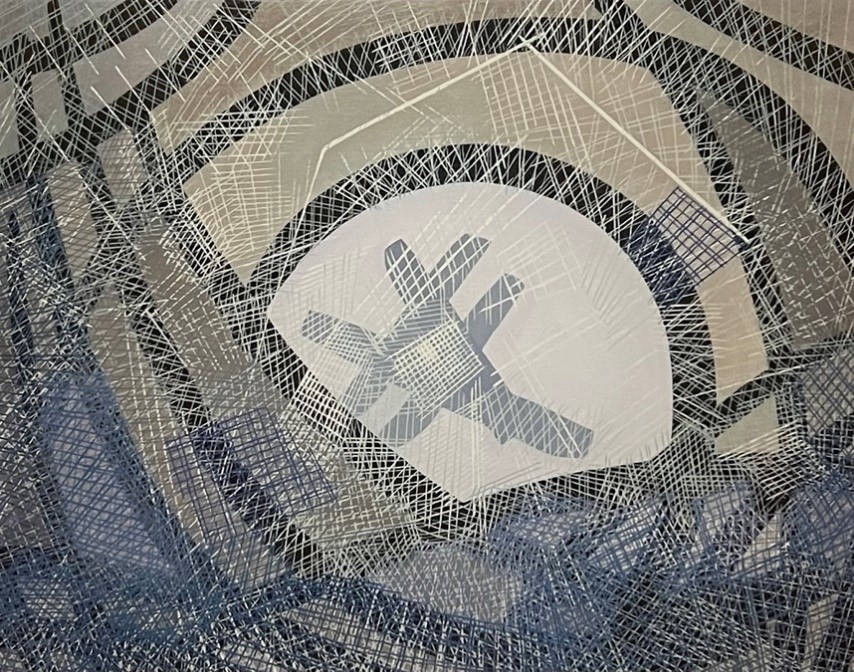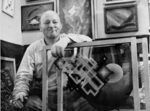
Fischinger Oskar
German, 1900-1967
Abstraction #22, n.d.
Oil on canvas
38 x 31 1/2 in.
SBMA, Gift of the Joel D. Rosenblum Trust
1991.170

Undated photo of Oskar Fischinger at Center for Visual Music
“Everything in the world has a spirit which is released by its sound.” – Oskar Fischinger.
RESEARCH PAPER
Oskar Fischinger (1900–1967) was a German-American animator, painter, and cinematographic director. He gained recognition for his innovative abstract works that harmonized shapes, colors, and music—decades before the advent of computer graphics and music videos, paving the way for experimental filmmakers and contemporary animators alike. He is widely celebrated as the father of visual music, with this groundbreaking concept becoming his artistic trademark. Fischinger’s meticulous approach was unmatched: “It could take him months to complete his work, and he did it with millimetric precision. Each of his drawings of geometric shapes, lines, or dots would be in exact time with the music—a dance for the eyes that few understood at the time, but which is now mesmerizing” (García, 2017).
Born on June 22, 1900, in Gelnhausen, Germany, Fischinger grew up in a musically inclined family, an influence that shaped his artistic pursuits. Initially trained as a violinist, organ-builder, and architectural draftsman, he later studied at the Academy of Fine Arts in Munich, where his passion for visual art and animation flourished.
Fischinger drew inspiration from the Bauhaus school and Wassily Kandinsky, the German Expressionist movement, and modernist trends. These influences profoundly shaped his creative output, which explored innovative animation techniques. He experimented with wax and clay models, liquid colors, and multi-layered engraving cameras to create groundbreaking visuals. However, his abstract art was labeled as "degenerate" under Adolf Hitler's regime. Faced with limited opportunities in Germany, Fischinger emigrated to the United States in 1936, where he continued his work as an animator and film director.
In Hollywood, Fischinger encountered significant challenges. He worked at Paramount, MGM, and Disney, but the constraint of studio demands often stifled his creative vision. He contributed to a scene for Disney’s Fantasia (1940), but it was ultimately removed for being “too abstract.” Fischinger created works through his own playful imagination. One of his standout works during this period was “An Optical Poem” (1938), created for MGM. This short film was a groundbreaking visual representation of music. Using paper cutouts suspended on invisible wires, Fischinger meticulously photographed each frame, one by one. The final product was perfectly synchronized to Liszt’s Hungarian Rhapsody No. 2, showcasing his unparalleled ability to translate musical compositions into visual forms.
Feeling restricted by the commercial focus of Hollywood, Fischinger shifted his attention to oil painting and spent his later years exploring kinetic sculptures. His paintings, characterized by abstract shapes and patterns, echoed the dynamic energy of his animations.
“Abstraction #22”, exemplifies Fischinger’s unique approach to geometric abstraction. The painting features precise, intersecting lines and geometric forms that create a sense of movement and tension across the canvas. At the center, a pale half-circle serves as the focal point, with surrounding shapes and lines achieving perfect symmetrical, a hallmark of Fischinger’s meticulous style. Unlike many of his other works, which often featured vibrant colors, “Abstraction #22” employs a monochromatic palette of blue and green hues. Layers of thin, vibrating fabric of lines add depth, guiding the viewer's eye and evoking a sense of motion as a testament to Fischinger’s animation background. As part of the modernist abstraction movement, “Abstraction #22” emphasizes pure form and visual experience, unburdened by traditional representational art.
Oskar Fischinger was a visionary who revolutionized the integration of music and visual art. Throughout his career, Fischinger produced over eight hundred canvases and more than fifty films. Fischinger’s dedication to his craft and his relentless pursuit of perfection have left an indelible mark on both animation and abstract art. Many of his works are now housed in major museums and collections worldwide. Works like Motion Painting No. 1 (1947) continue to inspire artists exploring the intersection of music and visual art.
While his work was often misunderstood or underappreciated during his lifetime, his legacy endures, captivating audiences and influencing generations of artists worldwide.
Prepared for the Santa Barbara Museum of Art Docent Council by Nina Sandvik Bashforth, 2025.
BIBLIOGRAPHY
Center for Visual Music. (2021). “Oskar Fischinger Biography.” Retrieved, January 25, 2025,
http://www.centerforvisualmusic.org/Fischinger/
García, Alberto Pascual. (2017). “Who was Oskar Fischinger, the father of visual music?” Retrieved, January 25, 2025,
https://quo.eldiario.es/ser-humano/a66683/oskar-fischinger
History Biography. “Oskar Fishinger Biography.” Retrieved, January 25, 2025,
https:/history-biography.com/oskar-fischinger/
Moritz, William. (1986). “Optical Poetry: The Life and Work of Oskar Fischinger.” Indiana University Press.
Santa Barbara Museum of Art. (2025). “Abstraction #22, Museum Art label.”
The Guardian.com. (2013). “Oskar Fischinger: the animation wizard who angered Walt Disney and the Nazis.” Retrieved, January 25, 2025,
https://www/theguardian.com/artanddesign/2013/jan/09/oskar-fischinger-animation-disney-nazis
